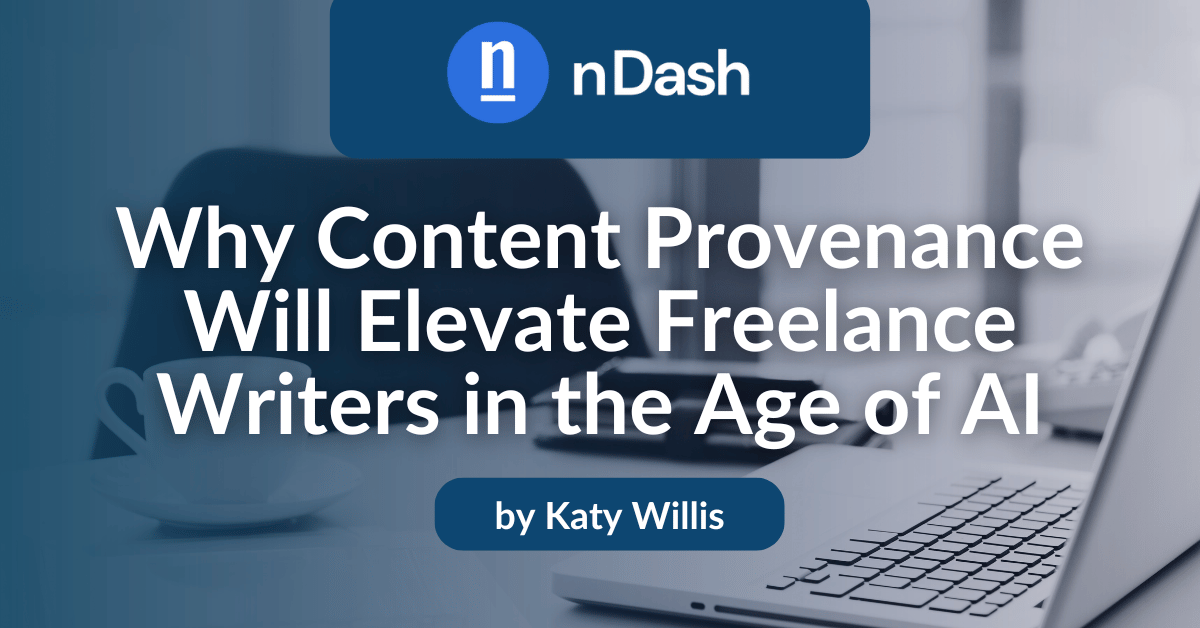Just 25.8% of web pages are “pure human,” meaning they contain no AI-generated content, according to Ahrefs. So trust and authenticity are becoming a brand’s most valuable currency. For many freelance writers, our industry has never been tougher.
The ever-increasing influx of AI-generated content is costing us clients and threatening our livelihoods. But as the public gets increasingly tired of AI word-vomit, brands and customers are crying out for trustworthy, human content. They want verifiable authenticity.
That’s where content provenance comes in. It’s emerging as a brilliantly useful safeguard for brands and freelancers. Content provenance proves where the content came from and who created it. Writers who make use of content provenance technology can prove their authorship with verified originality. This means we can command higher value and stand out from others as leaders in original, trustworthy content.
What is Content Provenance?
Content provenance is essentially a method for documenting and verifying the origin and history of a piece of content. It tracks who created it and how it’s been altered over its lifetime.
Technical Solutions
The Coalition for Content Provenance and Authenticity (C2PA) has created a system that acts like a digital fingerprint. The system tracks who made a piece of content and every change made to that content. It allows creators to embed cryptographic metadata, or content credentials, into files.
These serve as verifiable labels about who made the content, when, and with which tools. And, to guarantee authenticity, these credentials are backed by digital signatures. These are tamper-proof seals that signal if the content has been manipulated.
Brands are increasingly recognizing that pairing automation with the human touch is the key to creating content that connects. See how teams are achieving that balance.
Blockchain Content Verification
Blockchain content verification offers a different but equally valid approach. The WordProof project enables writers to timestamp their posts on a blockchain, thereby proving ownership and the timing of publication. When you publish an article, it generates a certificate showing when the content was created and by whom. And, because data is stored across a distributed ledger, it’s basically impossible to forge or erase.
Why Content Provenance Matters Now
Ahrefs’ recent analysis showed that 74.2% of newly published web pages contained AI-generated content. Additionally, 87% of content marketers admitted to using AI assistance, so AI-assisted content has quickly become the default.
The Trust Crisis
This deluge of AI material directly impacts audience trust. In one study, 55% of respondents felt uncomfortable consuming media they knew was AI-generated. They talked about concerns around accuracy, transparency, and ethics. Interestingly, 61% of consumers feel misled if they find that AI wrote an online product review without disclosure.
Industry Response
Major players in media (and in tech) are pushing provenance standards as a response to AI-driven misinformation.
The Biden-Harris administration secured voluntary commitments from AI companies to develop provenance tracking and watermarking for AI content. This wave of regulation is laying the groundwork for standardized AI content disclosure practices across the media and publishing industries.
The National Telecommunications and Information Administration states that the absence of provenance metadata could imply that content is AI-generated. But only if authenticated content becomes the norm.
The controversy around AI-generated novels in NaNoWriMo highlights growing concerns about authenticity and authorship. Content provenance offers a direct solution to these concerns. Read more about the ethical debate here.
How Content Provenance Benefits Freelance Writers
This shift is creating opportunity. Human creators who proactively provide proof of authorship are more trustworthy than those who don’t. Therefore, they’re more likely to succeed in their pitches and submissions.
Higher Rates and Premium Clients
Writes who can prove their content was created by them, and not by an LLM, immediately stand out. This signals higher quality, authenticity, and accountability, and attracts clients willing to pay a premium for trustworthy content.
An increasing number of advertisers are explicitly averse to AI-made content over fears it can harm their brand. And rightfully so. Therefore, if you can offer them proven human content, you stand a much better chance of landing the gig.
By offering verified human content, freelancers can tap into market segments that value human authenticity over rock-bottom content mill prices. New services like the Authenticity Initiative offer seals to authors who pledge not to use AI. Authortegrity is developing certification for human-authored books.
Build Trust Through Human Nuance
It’s true that, if prompted well, AI can generate competent copy. But it lacks the nuance, voice, and perspective that humans bring. One study showed that over 50% of readers become less engaged if they feel an article wasn’t human-written. Plus, 20% of consumers said they’d consider a brand untrustworthy if they used obviously AI-generated social media posts.
Future-Proofing Your Career
As we move further into the AI-drenched internet, brands and their customers will continue to seek out real, human voices. It’s highly likely that major publishing platforms, search engines, and marketplaces will require or highlight provenance information. Freelance writers with verifiably human portfolios will have a major advantage. The edge emerges when “verified author” badges and other forms of tamper-proof provenance become the standard.
Provenance also protects against false accusations. It’s all too common for clients to be mistrusting and immediately throw an accusation of “I think you used AI”. And it’s not that surprising. AI checkers are essentially useless. OpenAI shut down its AI-written text detector due to “low accuracy”. Another popular tool misidentified the U.S. Constitution as an AI-written document. I even did a test myself.
I took a piece of content I wrote and ran it through four so-called AI detectors. Obviously, it was verifiably human-written, because I researched and wrote it myself. Two came back as 100% human, the other two both flagged the content as AI-generated. I made some tweaks until the latter two agreed that the content was human. However, one of the former flagged the content as 65% AI, and the other as “likely majority AI-generated”.
But, by attaching irrefutable proof of authorship, you have a defense against your content being mislabeled as AI-generated. Provenance data serves as professional insurance, certifying your skills and reputation.
Practical Steps for Freelancers
Start by publishing on platforms supporting provenance data. For WordPress, for example, consider integrating WordProof, which timestamps content on a blockchain and provides certificate badges. You can also make use of digital signature tools like Adobe Acrobat’s certificate feature. Choose tools that create tamper-evident records and adopt new offerings early. And get in the habit of adding provenance to your content today. You don’t have to wait for a wider CP2A rollout.
Publish Where a Public Timestamp Does the Heavy Lifting
I already mentioned WordPress, but Medium and Substack also assign a verified “first seen” date. For critical content, use the Wayback Machine. This gives you an independent archive record the same day you publish.
Add Vital Details to Every File
Before exporting, pop into your document properties and fill in the author, title, and comments fields. Add your name (or pen name), the date, the tool you used, and a quick version tag. All of these fields travel with the file, even if someone renames it later.
Seal the File with a Digital Signature
A PDF is by far the easiest format to lock down with a signature seal. Open your PDF in something like Adobe Acrobat, then add your certificate-based signature. The document is stamped at the exact time the signature was applied, and any edit breaks the seal.
Burn Your Byline Right Into the Content
Add a tiny footer that says “Written by (your name)” and include the date you finalized the piece. Even if someone strips the metadata, that line stays visible to readers and crawlers.
Keep Every Draft
Version history in Google Drive or Dropbox, for example, tracks text evolution over time. This proves content developed over days or weeks and wasn’t conjured in seconds by an LLM. You can also label each significant version so you have a sequence, like “draft”, “rev-1”, and “client-approved”. If there’s ever a query or dispute, you have an unforgeable breadcrumb trail baked right into your document.
Stay Ahead of the C2PA Rollout
Get in the habit of providing as much content provenance as you can right now with the methods above. With Adobe, make use of their Content Credentials panel, which is currently in beta in Photoshop, Express, and Acrobat. Toggle on this feature, and your files will carry an industry-standard label that states who created them, how, and when.
Emerging Opportunities
Content provenance is quickly becoming more of a competitive edge for freelancers, as well as a defense against AI. As trust becomes a premium currency, writers who can prove authorship will stand out in a crowded, machine-made market.
Consumers and clients sick of generic AI drivel will seek out verified human writers. So it’s logical that platforms and publishers will prioritize provenance-verified creators. We’ll also likely see “certified human” seals.
Consumers are demanding more transparency around AI-generated content, making disclosure and provenance critical for maintaining trust. Explore the findings here.
Governments are already considering making AI disclosures mandatory for the media. Early adopters of provenance tools and practices will be best positioned to benefit when these technologies become mainstream.
Content Provenance is the Future
As AI floods the web with passable but mediocre content, the pendulum of consumer wants is swinging back hard towards authenticity. Content provenance and digital content authenticity provide readers with a means to trust what they see. They also give writers a way to prove they’re the real deal.
For freelancers, this is both a lifeline and a launchpad. Those who embrace provenance tools can build a trusted brand around their name and work.
In the age of AI, the new rule is simple: If you wrote it, prove it.
About the author:
 Katy is a seasoned freelance writer, editor, and content manager specializing in creating high-quality, SEO-driven content for diverse industries. With over two decades of experience, she has collaborated with businesses, charities, and entrepreneurs to craft engaging content. Check out her writer profile to learn how her expertise can help level up your content strategy: Katy Willis.
Katy is a seasoned freelance writer, editor, and content manager specializing in creating high-quality, SEO-driven content for diverse industries. With over two decades of experience, she has collaborated with businesses, charities, and entrepreneurs to craft engaging content. Check out her writer profile to learn how her expertise can help level up your content strategy: Katy Willis.
